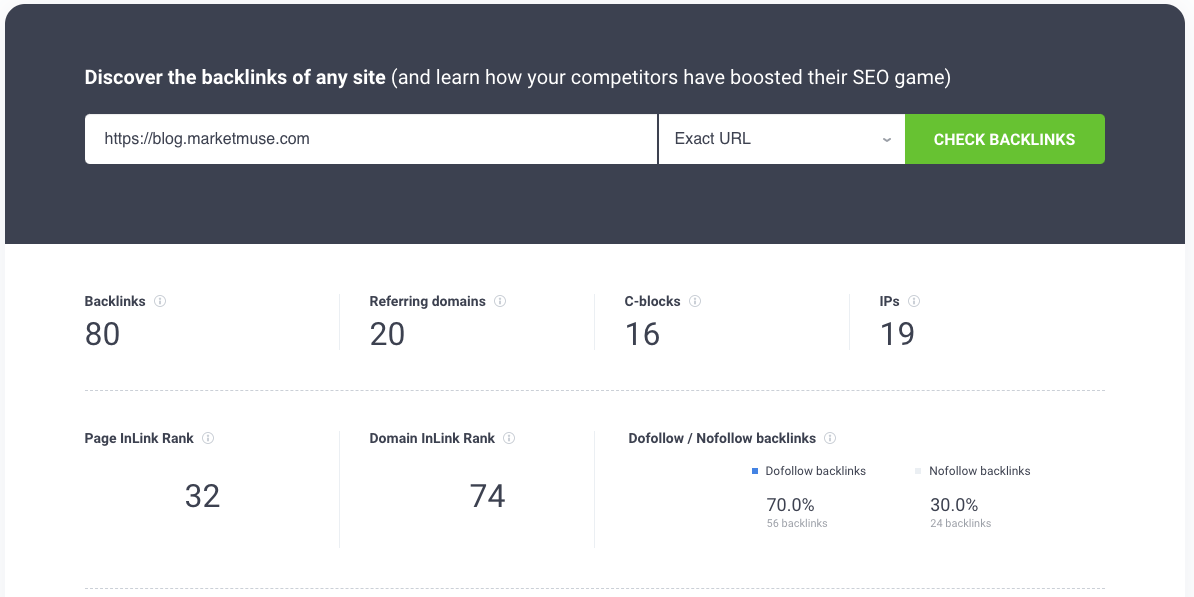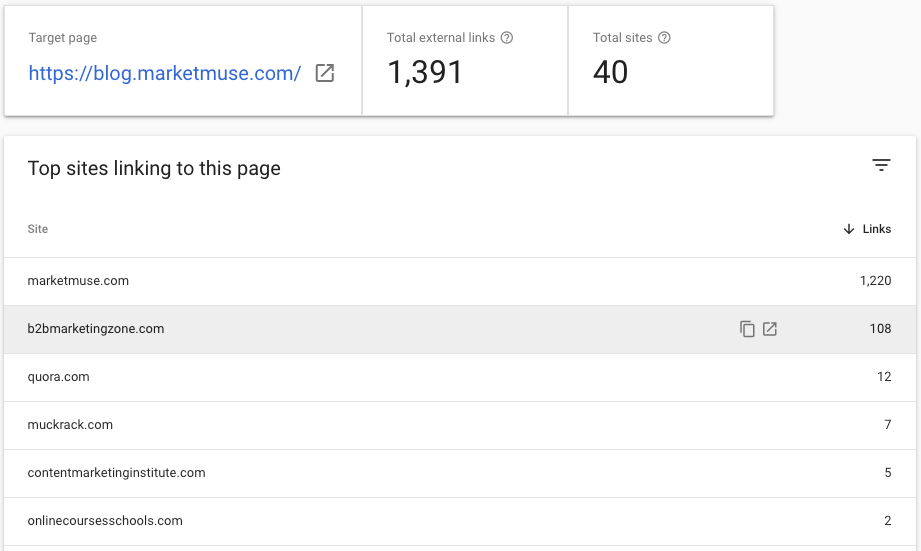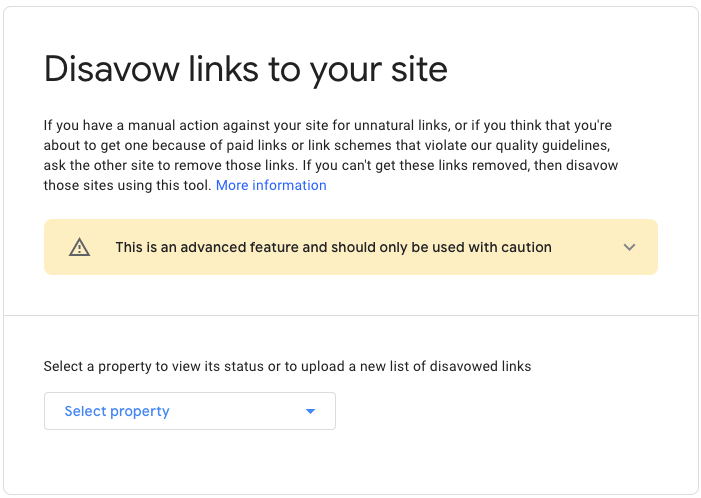Backlink Analysis: Getting the Most Out of Link Building
Link analysis provides insight into your site’s link profile and that of the competition. Beyond discovering where to get backlinks, this type of examination helps determine backlink quality.
Furthermore, conducting this type of competitive research maximizes the ROI of your link building efforts. You’ll quickly identify high-quality and high-probability linking opportunities.
Routine examination of your site’s link profile can also reveal links, the nature of which may lead to a manual Google penalty. These links can occur on your part either intentionally or unintentionally, although occasionally they’re the result of bad actors within your market space.
This is the second chapter in our guide to link building, covering the basics of link building, including link analysis, outreach, digital PR, and internal linking.
Link Building for SEO Guide Index
- Link Building for SEO: A MarketMuse Guide
- Backlink Analysis: Getting the Most Out of Link Building
- Link Building Outreach: Tips, Tools, and Tactics
- Link Building With Digital PR
- How MarketMuse Scales Your Linking Strategy
Let’s see what we can learn from backlink analysis and how to take corrective action if necessary.
What is Backlink Analysis?
Backlink analysis is an important factor contributing to strong link building and Search Engine Optimization (SEO) for a domain or individual webpage.
In general, there are two types of backlink analysis: partial backlink analysis and full backlink analysis. Partial backlink analysis refers to analyzing the backlink profile of individual web pages or subfolders on your domain, according to a defined set of SEO metrics. In contrast, full backlink analysis is done with the total of all backlinks on a domain.
Usually, a backlink profile is a simple list of source pages and their anchor text. It’s used as an abstract way of describing the combined backlinks without going into the exact particulars of why it’s a strong backlink.
How to Use Backlink Analysis to Get the Most Out of Link Building
Ever wonder where the competition gets all their backlinks from? A competitive bank analysis will answer that question.
More importantly, a qualitative analysis will help you get the most out of your link campaigns by focusing on high-quality opportunities. While link quantity once ruled SEO, that’s taken a back seat to quality.
A link profile is the combined list of all backlinks on a domain or single webpage. Some SEOs take this to the extreme, comparing their link profile to the competition in order to sculpt a similar result.
We’re not saying you need to go that far. But if you’re going to spend time building links, it makes sense to focus on those coming from relevant, high-authority pages where you can obtain an editorial (in-content) link.
After building successful links, you should do another backlink analysis for comparison. This examination ensures that the link building you’ve done has improved the strength of your domain’s backlink profile, which may improve its search engine ranking.
How Do You Perform a Competitor Backlink Analysis?
One of the most insightful types of competitive backlink analysis is performed directly on your competitors’ backlinks. First, you need to determine your direct competitors if you don’t already have a list. Check the search engine results page (SERP) for your most important search terms to get a sense of who your competitors are in search. These may be different than what you’d normally consider to be the competition.
Usually you’ll be competing for search engine ranking with those websites — regardless of region — that share expertise with your company and who you’re competing with in keyword ranking. Knowing what your competitors are linking to is often an incredibly effective link building strategy.
There are many free and paid tools available for analyzing competitor backlinks. Keep in mind that you get what you pay for, however. Free options will likely contain ads and less in-depth analysis, while paid reports will contain a robust, exhaustive backlink analysis. Yet, free options may still be a useful starting point.
Below we’ve outlined some of the most effective tools for analyzing backlinks for both your own domain and your competitor’s.
What Do the Backlinks in the Report Mean?
The backlinks in a report are the source page that the anchor text (or a competitor’s backlink) brings a viewer to once they click on it. Using a backlink analysis tool, you can determine what links are working and which are bad or toxic links. You can then use this information to influence your link building strategy.
If you find that your domain or a specific webpage on your domain contains broken links, you can do link reclamation to find and fix broken or lost backlinks. You’ll next want to update them with updated URLs.
A backlink checker tool automates this process, so you don’t have to click through every link manually to determine if any are broken.
Backlink Analysis Benefits
Although links have diminished in importance over the years, they still act as a vote of confidence. A link from a relevant and well-established source is a sign of credibility — these days it’s quality over quantity.
Regular domain maintenance should include a backlink and SEO audit to maximize your backlink analysis benefits. As backlinks will change over time — you win some you lose some — analyzing your backlinks will avoid any unpleasant surprises and keep you abreast of new opportunities.
What Insight Can Backlink Analysis Provide About Your Own Site?
Numerous backlink analysis benefits can be gained from a proper audit. That includes an understanding of the quality of backlinks, their relevance, and their use of anchor text.
Quality backlinks are those that:
- Come from reputable pages
- Are relevant
- Use appropriate anchor text.
- Appear in the main content (as opposed to header, footer, or sidebar)
Backlink analysis can reveal how well you are achieving the objective of acquiring high-quality links. Likewise, it can help reveal deficiencies that may be affecting your ability to rank.
What Can You Learn by Conducting a Backlink Analysis of Your Competition?
While rank tracking can tell you how well a page is doing, backlink analysis provides at least part of the answer as to why a page is doing that well. The same analysis you’d do on your own site can be done on the competition’s while revealing new link opportunities. No more will you wonder where they get their links!
Backlink Analysis Tools and Data
We get it. All of this may sound complicated. And if you’re not an SEO expert, it may sound like a different language full of highly technical mumbo-jumbo. The good news, however, is that there are many excellent backlink analysis and other SEO tools available.
Let’s talk about SEO backlink analysis tools and data they provide. Some are free. Some are paid. The free options provide information that’s certainly good to have. But the paid options will provide you with greater insight plus better and more reliable data.
Ahrefs has a free backlink checker that requires no signup. It provides a number of valuable link metrics, and more importantly, they appear to have the best backlink data. But you won’t see all your backlinks in the free version — for that you’ll need to upgrade to a paid one.

SEO Spyglass also has an offering, but it’s not able to detect as many backlinks as Ahrefs.

Google Search Console is a versatile tool for a number of reasons. But those using it for backlink analysis may find it limiting. While you can get a list of backlinks to one of your pages, there are no associated metrics. Also, note that this can only be used with a site that you verified — so you won’t be conducting any competitive link profile analysis with this tool.

Backlink Quality Assessment
Backlink quality is now more important than the number of backlinks received — a marked change from a decade or so ago.
What Criteria Makes for a Quality Backlink?
A good backlink has distinct characteristics. When performing a backlink quality assessment, keep these factors in mind. This criterion includes:
Page Authority
While some feel that Domain Authority is important, Page Authority directly equates to how valuable a link is. If a beneficial, high-traffic page on an equally high-traffic domain links to your website content, search engines take that as a vote for the quality of your content.
Page Relevance
There needs to be some degree of relevance between your page and the referring one. Intuitively, this makes sense. After all, without that relevance, anyone clicking on the link will quickly leave once they discover the linked page has no relation to the topic they are pursuing. Google can determine this quite easily by measuring bounce rate.
Page Quality
High-quality pages are those that exhibit high amounts of expertise, authority, and trustworthiness. You can evaluate them using the same criteria as Google does in their Search Quality Rater Guidelines. Alternatively, you can use proprietary metrics such as Domain Authority (DA) and Page Authority (PA). Backlinks analysis tools typically provide these metrics and are a good proxy for quality.
Link Position
A link from the main content has more value than one coming from a footer, header, or sidebar. In part that’s do to the surrounding text providing more context as to the relevance of the link. It’s not all about the anchor text, as this article by Bill Slawski explains.
How Do You Identify Bad (Toxic) Links?
Toxic links are bad links, although it’s not a question of quality. They’re ones that could result in a manual penalty, affecting your ability to rank.
Anything that suggests a linking scheme should be considered toxic. There are all kinds of signs that can indicate these types of links, including:
- The linking domain isn’t indexed by Google (that could be the result of a manual penalty).
- The site looks as though it exists solely for the purpose of linking.
- The linking domain appears to be part of a private blog network (PBN).
- The anchor text is over-optimized (the same phrase being used consistently as anchor text is unnatural).
- The referring page is infected with malware.
- The link comes from an unmoderated forum.
- The same page can be found on different domains linking to your site (mirror page).
You can read more about how Semrush’s Backlink Audit Tool applies different toxic markers to a link in order to determine its toxicity.
How Do You Remove Toxic Links?
Toxic links can be removed using Google’s Disavow Links Tool accessible through Google Search Console.

Take note that you should only use this approach in the most dire of situations. If you have a manual action against your site for unnatural links, or think you may get one, ask the other site to remove those links. If that’s not possible, then as a last resort you can disavow those sites using their tool.
Basically, you create a text file of the links, domains, or subdomains using a specific format and upload that to Search Console. Here are Google’s instructions.
Takeaway
There are high-quality links, low-quality ones, and everything in between – and then there are those considered toxic. Link analysis helps you identify situations that could negatively impact your site’s ability to rank. Conducting the same analysis on your competitors can reveal new opportunities to gain relevant high-quality backlinks.
Link Building for SEO Guide Index
Stephen leads the content strategy blog for MarketMuse, an AI-powered Content Intelligence and Strategy Platform. You can connect with him on social or his personal blog.